Crop diversity and crop rotation improve pest management in canola and all other crops. Breaks of at least two years between canola crops will reduce risk from clubroot and blackleg diseases, reduce selection for weed resistance, and increase crop yields.
Research in Western Canada identified three factors that increase the risk of canola yield loss in short rotations – blackleg, clubroot and cabbage root maggot. This article discusses these and other important factors related to rotation as risk management. (The Canola Encyclopedia has a chapter on rotation.)
Blackleg
A one-year break between canola crops can reduce the carryover of the blackleg fungus on canola stubble, but at least two full years (one in three rotation) is recommended to reduce blackleg severity and the risk of yield loss. A three-year break (one in four rotation) effectively eliminates yield loss risk from blackleg. (See Figures 1 and 2.) In most cases, a two-year break in combination with blackleg resistant (R) cultivars provides sufficient risk management.
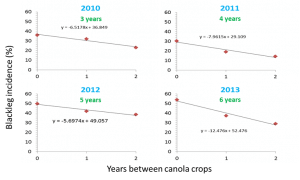
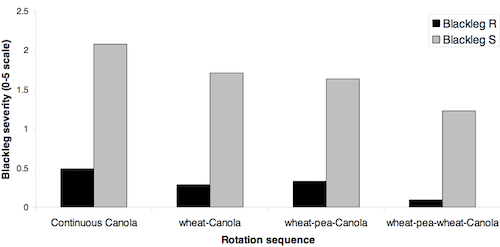
But is the cutlivar resistant to blackleg races in a field? Scout for potential change of blackleg resistance. Blackleg severity scores of 2 or more in an R-rated hybrid is a sign of race shift. (See the rating scale below.) On that field, canola may need a three-year break or rotation to hybrids proven to have different blackleg R genes. (Study showing rotation benefit for blackleg management.)
Fungicides may provide some yield benefit if applied in early growth stages and only when hybrid resistance is no longer functional.
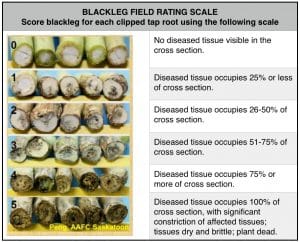
Clubroot
Pathogen spore load, disease risk and yield loss increase substantially when canola is grown frequently on clubroot-infested fields. Growing resistant hybrids is an effective management tool when used in combination with at least a two-year break between canola crops.
Evidence from three rotation studies in Canada (two at Normandin, Quebec, one in Alberta) indicate that two years between host crops (one in three rotation) is the minimum rotation to manage clubroot spores in a field. Thomas Ernst, who did the Alberta study, observed an eight- to 20-fold drop in resting spore concentrations with a two-year break after growing clubroot-resistant canola. With a one-year break, Ernst found that resting spore numbers never drop enough to provide any reduction in risk.
Gary Peng, research scientist with Agriculture and Agri-Food Canada (AAFC) in Saskatoon, led one of the Quebec studies. In fields with heavy clubroot infestation, Peng showed that a two-year break between canola crops can reduce the pathogen inoculum in the soil by up to 90 per cent relative to a one-year break. Yield benefits from this two-year break showed in resistant cultivars as well as susceptible.
Peng assumes this same pace of breakdown occurs with lightly infested or patchy disease fields, but his research was not done on lightly infested ground.
Note: A 90 per cent reduction in spores in a heavily infested field or patch still leaves a significant spore load for infection to occur and potentially break the clubroot resistance used. A longer break combined with patch management is advisable in high spore loads.
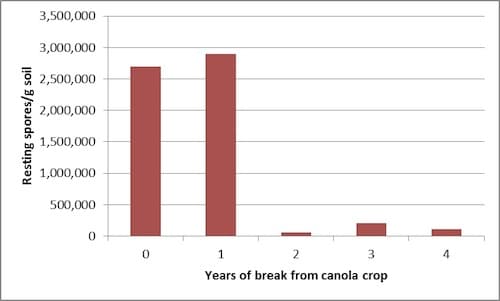
Cabbage root maggot
An AAFC rotation study showed that with continuous canola, root maggots caused a statistically significant increase in crop damage. A one-year break between canola crops significantly reduced yield loss as a result of root maggots, the study found. No insecticides are available to control root maggot in canola so rotation is especially important to prevent outbreaks of this pest.
Other factors
Disease and insects
Sclerotinia stem rot, verticillium stripe and flying insects – flea beetle, bertha armyworm moth, diamond back moth, cabbage seedpod weevil and lygus bugs – increase in severity as canola frequency and overall acres increase. However, these pests are mobile. Only a region-wide reduction in canola and other host crops will reduce their risk significantly. Long rotations on an individual farm will have little risk management benefit for these pests.
Volunteer canola
Christian Willenborg, University of Saskatchewan, found that volunteer canola is the major weed associated with continuous canola cultivation. Volunteer canola presents various risk. These include yield reduction, unwanted competition to the seeded crop and increased disease build. They can also reduce harvest quality if volunteers mature later and increase green seed counts.
The study showed relatively few weed species, other than volunteer canola, associated with continuous canola cultivation. This can be attributed to the high efficacy of the herbicides used in herbicide-tolerant canola production.
However, Willenborg says the risk of developing herbicide resistant weeds under continuous canola production is high.
With short breaks between canola crops, rotate among herbicide tolerance systems and use pre-seed and fall herbicide timing in addition to in-crop application. Rotation with other crops provides expanded options to rotate among herbicide groups. Winter cereals or perennial legumes can be part of a system of integrated weed management.
Crop nutrition
Crop nutrition is not a risk factor with shorter canola rotations, however yield reduction can occur in a tight canola rotation if fertilizer rates do not match canola’s high nutrient removal rates. Higher fertilizer rates can compensate for some of the yield loss from shorter canola rotations, but as John O’Donovan’s AAFC rotation research showed, higher nutrient rates cannot completely close the yield gap.
O’Donovan, now retired, looked at canola on canola, canola on wheat, and canola on several pulse residues. Canola responded positively to increasing rates of nitrogen (N) on all residue types including canola. However, at each N rate, yield for canola on canola was less than for canola on the other residue types. Also, the pulse residues generally resulted in higher yields than wheat residue. See the graph below for study results.
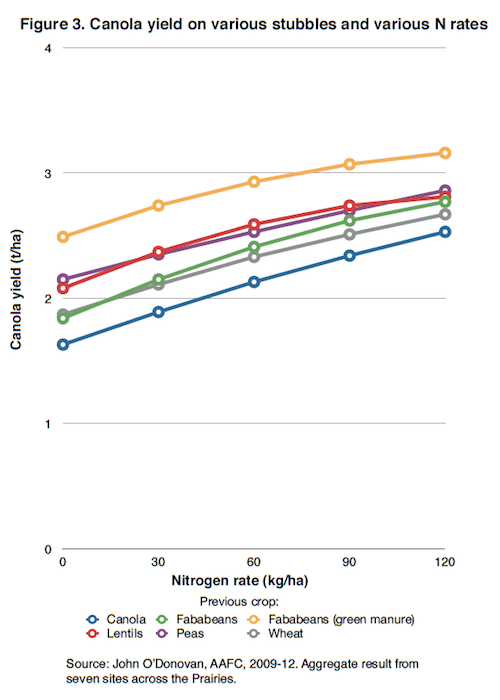
Soil microbial fauna or soil water availability could also contribute to lower yields for canola on canola stubble, but these factors have not been researched, and the risk — if there is one — is unknown.
More…
- Please read the Canola Encyclopedia chapter on crop rotation.
- Do a keyword search for “rotation” at Canola Research Hub
